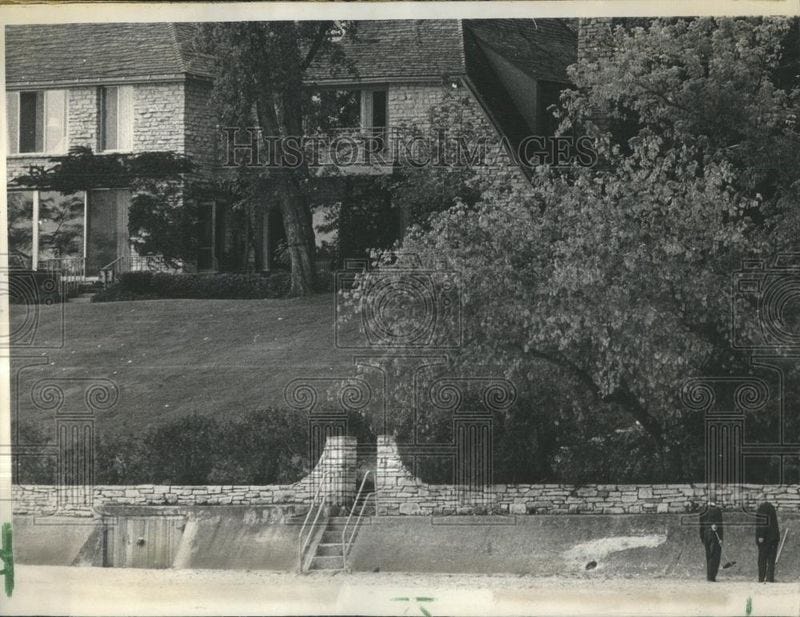Unsolved '66: The Crime Scene
Valerie Percy's killer murdered sixty-nine others and it was covered it up. (2nd in a series)
By early 2011, I was living back in the Chicago area.
On a trip home the previous Christmas, I realized that my mother was becoming unable to care for her home. While needing a long-term plan for her care, I moved back to the area.
One sunny spring day, I called a friend, Bill Wallace, and asked if he wanted to get lunch somewhere. We agreed on pizza at a place in Wilmette.
Though I hadn’t thought of it, the restaurant just happened to be located a few blocks down Sheridan Road from Chuck Percy’s former home.
I believe Bill was driving. When we stopped at the corner of Kenilworth Avenue and Sheridan Road for a red light, he interrupted me by shouting: “They’re tearing Percy’s house down!”
It was an understatement. The house already had been torn down. It was gone, and the lot looked almost unrecognizable without it.
Bill parked the car, and we walked a quarter block to Devonshire Lane, Percy’s former address.
A minute or so later, he marched onto the property. With a little hesitation, I followed.
Nearby, four or five Hispanic men were sitting near the center of the lot, eating their lunches. They didn’t seem to mind our presence.
What was left of Percy’s house was lying in its basement: splintered chunks of wood, torn pieces of plaster walls, and fieldstone from the home’s exterior.
Some basement walls were intact, painted and papered in colors reminiscent of the sixties and seventies, bright orange and avocado green.
The pool house was mostly intact, though one of the huge backhoes that was parked nearby had smashed a sizable hole in its roof. The farmhouse had already been demolished and carted away.
Efforts had been made to save it. However, no one was willing to spend the money necessary to relocate it.
As we walked around the lot, I took pictures with my phone. After a few minutes, we left. The crew were still on their lunch break.
Later that day, I pitched a story idea to the Pioneer Press about the home’s history and demolition and got the go-ahead to write it.
A few days later, I thought of a lifelong friend, Jim Dearborn, who had been my neighbor in Wilmette. I called him and asked: “Wasn’t your Mom friends with the Percys?”
Yes, Jim explained. His father, Richard, knew Loraine Percy, Chuck Percy’s second wife, in college.
I was soon on the phone with Jim’s mother, Georgia, whom I had not spoken with in more than thirty years. She shared with me her memories of the house and the times she visited there as well as her experiences working as a volunteer for Chuck Percy’s first political campaign, his failed race for governor of Illinois in 1964.
Georgia was also kind enough to arrange for a phone call between myself and Loraine Percy. Loraine, too, shared memories of her family’s home in Kenilworth—but only the good ones. I did not ask her about Valerie’s murder.
I had long been intrigued with the mid-1960s and wondered whether a book chronicling Chuck Percy’s first two political campaigns (1964 and 1966) would be worth researching.
Georgia’s stories about them were intriguing, especially the 1964 run, when a group of volunteers helped their friend, who had virtually no name recognition outside of business circles, vie for statewide office.
Her stories included the US Senate race that followed two years later when, during its home stretch, Valerie was brutally murdered, touching off a massive investigation that ultimately was unsuccessful in delivering justice for Valerie and her family.
That said, what could a book about the murder achieve? Hundreds of news stories covered the investigation throughout the years. They would be great material for a book, but what more could be learned about the crime?
Little, it seemed, though I could not have been more wrong about that.
In the meantime, Georgia Dearborn put me in touch with Chuck Percy’s former campaign aide, Neil Burghard. Burghard’s stories about those early campaigns, Valerie’s murder, and his campaigning with her father in the wake of it were no less intriguing.
I spoke with a few others who had worked for Percy at that time, but many of the early campaign’s staff were deceased, and there wasn’t enough material for a book. So, regrettably, and after not a little amount of work, I shelved the idea.
However, at some point I decided to try to locate some new sources.
The next one had information that no one had seen, a document that described the scene inside of Chuck Percy’s house that dark morning, minutes after Valerie was brutally murdered.
The book idea resurfaced, though the information that would come my way was less about Percy’s campaigns and more about the unsolved murder of his daughter.
There’s more to this. The story continues here and please subscribe:




Cold cases are sad. Grieving families and friends of murder victims wait for years in hope of some sort of official answer as to what happened. It is good when cold cases are solved, especially when the killer is arrested, and evidence is officially presented in court. Sad that the Percy family never saw this happen.